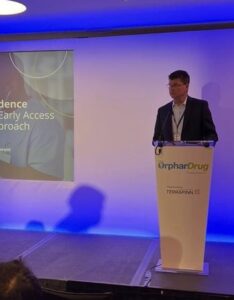Imagine that your loved one is diagnosed with a rare disease. The first thing you do is to go to the internet to understand what you can about this disease including how the disease is treated. You learn that, as for most rare diseases, no approved medicine exists. You also learn there is a pharmaceutical company developing a new treatment. You see in the company’s press releases that early clinical trial results have been promising, and there is another clinical trial currently enrolling new patients.
You speak with your doctor and ask her to reach out to the company to find out if enrollment into the clinical trial is a possibility for your loved one. Unfortunately, your loved one does not meet the entrance criteria the pharmaceutical company uses to determine eligibility for the clinical trial.
The clinical trial and regulatory process can be lengthy, meaning in a case like this, one may not get access to an investigative treatment for years. While no investigative treatment in clinical trials is guaranteed to work in all patients, depending on the disease, waiting without a treatment may be a guaranteed death sentence. Knowing this, you want to try anything that shows promise for your loved one.
Alternate Options to Get Access to Investigative Medicine
Most countries in the world allow a patient under the treatment of their doctor to receive access to new therapeutics outside the clinical trial process when the patient does not qualify. This type of access is also relevant for a large portion of patients who live in countries where this new innovative medicine will never be launched. This may be called compassionate use, managed access, early access, expanded access, or named patient supply.
Within the United States, Europe, and beyond, the legislation and process to get access to an investigative medicine varies from country to country, but one fundamental element is that a physician must init
ate a request on behalf of their patient. The request often needs to be approved by the pharmaceutical company, and in virtually all countries, the local health authority must give permission for the doctor to have the medicine imported for their patient.
An early access program is a formal mechanism put in place by a pharmaceutical company that utilizes the different country legislations to facilitate access to these medicines in a controlled way. An early access program may have inclusion and exclusion criteria like a clinical trial, so all patients with a specific disease may not qualify. In some cases, a pharmaceutical company may choose to provide the medicine to the patient free-of-charge while in other cases, the medicine may be charged for.
Expanded Access in the United States
In the United States, the Food and Drug Administration (FDA) established a formal mechanism called expanded access in 1987 in response to the HIV/AIDs crisis. The term “expanded access” is specific to the United States. Depending on the severity of the patient’s disease, the FDA may allow access early in the development process for the new medicine while clinical trials are still ongoing. The FDA has determined that expanded access may be appropriate when:
- The patient has a serious or immediately life-threatening disease or condition;
- There is no comparable or satisfactory alternative therapy to diagnose, monitor, or treat the disease or condition.
- Patient enrollment in a clinical trial is not possible.
- Potential patient benefit justifies the potential risks of treatment.
- Providing the investigational medicine via expanded access will not interfere with investigational trials that could support a medicine’s development or marketing approval for the treatment indication.
Since 1987 the FDA has established three main forms of expanded access that get used at different stages of a medicine’s development. These are called Single Patient IND, Intermediates Size IND, and Treatment Protocol. In cases where the patient cannot enroll in an existing clinical trial, a doctor can apply for expanded access via a Single Patient IND.
First, the patient’s doctor must contact the pharmaceutical company developing the investigative medicine to find out if the company is willing to make the investigative medication available via expanded access. The company will normally review the case with the patient’s doctor to determine if they think the patient is a good candidate for their medicine.
The company is not obligated to supply the medicine under expanded access, and there may be good reasons why they say “No”. However, the company may change this decision to a “Yes” in the future as more safety and efficacy data comes from clinical trials.
If the company is willing to supply the medicine, the doctor must then submit a request to the FDA to get approval. They explain details about their patient’s disease and justify why the patient has no alternative treatment options and should receive the medicine under expanded access. The doctor takes responsibility for reporting to the FDA any information about adverse events that happen while being treated with the investigative medicine.
After the FDA approves use of the medicine under expanded access, the pharmaceutical company arranges for the medicine to be shipped to the doctor, or directly to the patient if the patient cannot travel to the doctor’s location.
The FDA has a track record of being willing to approve requests for expanded access, especially when patients have run out of other treatment options and cannot enroll in a clinical trial. In fact, data published most recently from 2023 indicate that FDA approves over 98% of these requests on an annual basis.
The 21st Century Cures Act
In 2016 the US federal government helped patients and patient advocates by signing into law The 21st Century Cures Act (Cures Act). The Cures Act helps accelerate medical product development and more efficiently brings new innovations and advances to patients in need.
One provision of the Cures Act ensures that pharmaceutical companies developing a medicine have a publicly posted policy (typically on their website) for evaluating requests for expanded access. Companies may take very different approaches. For medicines early in development this statement may simply say that expanded access is not being offered while clinical trials are ongoing. However, as more data is gathered from clinical trials, there is often increasing willingness to allow expanded access.
Per the Cures Act, companies are supposed to include the anticipated time it will take to acknowledge receipt of a request in their EAP policy. The actual time can vary. Big companies with established medical departments may respond sooner than small companies with limited resources. Also, if the disease or condition is immediately life threatening, the company will likely respond faster.
For those looking for more information about expanded access, The Reagan Udall Foundation for the Food and Drug Administration has developed a helpful resource for patients, caregivers and doctors. https://navigator.reaganudall.org/. It can be beneficial for patients or caregivers to learn as much as possible about expanded access if it is their only option to get an investigative medicine prior to FDA approval.
The rare disease journey is incredibly challenging given that so few approved medicines exist. It is vital for patient groups, patients and care givers in the United States to understand that expanded access may be a life-saving or life-changing option.

Source: John Lagus
John is the founder of Bluestem Pharma Consulting, LLC, helping patients around the world access medicines to treat serious or life-threatening diseases. John works with pharma and biotech companies to better understand and implement best practices for global early access and expanded access programs that meet a patient’s unique medical needs.
Early in his career, John was introduced to the orphan drug and rare disease space, when he joined
Orphan Medical to oversee development and FDA approval of ANTIZOL. Early access strategies were utilized to supply several of the company’s FDA-approved medicines to patients outside the US.
Over the years, John has gained extensive experience with the design, set up, and implementation of more than 200 global early access programs. John also provides help to patient groups and those they serve. Supporting the rare disease community continues to be his passion.
Contact John at [email protected], visit his website https://bluestempc.com/, or connect with him on LinkedIn. 


